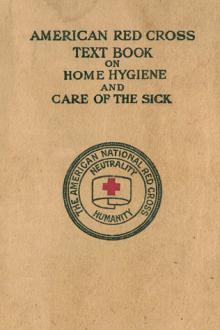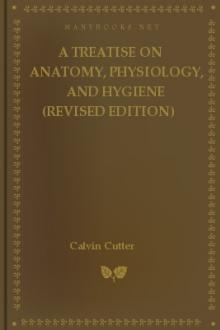American Red Cross Text-Book on Home Hygiene and Care of the Sick by Isabel McIsaac (best affordable ebook reader txt) 📕

- Author: Isabel McIsaac
- Performer: -
Book online «American Red Cross Text-Book on Home Hygiene and Care of the Sick by Isabel McIsaac (best affordable ebook reader txt) 📕». Author Isabel McIsaac
To some extent all hot applications are counter-irritants, but mustard pastes, mustard leaves, and the mustard foot-bath already described are the counter-irritants most commonly used.
Mustard Paste.—To make a mustard paste, mix dry mustard with flour, using for adults one part of mustard and six of flour to make a weak paste; increase the proportion of mustard up to equal parts of mustard and flour, according to the strength required. Use a smaller proportion of mustard for children; one part of mustard with from 6 to 10 parts of flour is generally enough. Add to the mustard and flour enough tepid water to make a paste, which must be absolutely free from lumps. Do not use hot water for this purpose, because it destroys some of the active properties of the mustard. Spread the paste on thin muslin, apply it to the skin, and remove it as soon as the skin is reddened so that its color resembles that of a strong sun-burn. If the skin is especially sensitive, mix a little sweet oil or vaseline with the paste.
Mustard leaves should be dipped in tepid water and may then be applied to the skin directly, but if specially sensitive, the skin should be protected by thin muslin or gauze. The leaf should remain until the skin is well reddened; a few minutes are generally sufficient.
Care must be taken not to leave either a mustard leaf or a paste in place long enough to blister the skin. After the application has been removed; the part should be protected by a soft cloth until redness disappears. Vaseline or sweet oil should be applied to the skin if it is greatly irritated.
Other counter-irritants in common use are iodine, turpentine, ammonia, kerosene, camphorated oil, capsicum vaseline, and various liniments. Tincture of iodine may be diluted with alcohol for especially sensitive skins; it sometimes causes blisters, and should not be applied more than once a day at most. Ammonia and turpentine cause blisters; they should not be used as counter-irritants except by a doctor's order, and then only after exact directions have been obtained. Turpentine and kerosene are inflammable and hence dangerous to use. It should be remembered that the action of all counter-irritants is physiologically the same, so that no advantage is obtained from the use of dangerous substances like kerosene and turpentine.
EXERCISES What are the causes and symptoms of inflammation? Describe the process of inflammation. What is the effect of heat on an inflamed area? of cold? What are the dangers from hot applications, and how may they be guarded against? How should you fill a hot water bag? How should you cover it? Describe the method of preparing and applying a flaxseed poultice. Tell how to prepare and apply fomentations. How should you apply cold compresses to the head? to the eyes? How should you make a mustard paste for a baby six months old? for a grown person only slightly ill? for a feeble old person with a sensitive skin? FOR FURTHER READING Essentials of Medicine—Emerson, Chapter I. The Human Mechanism—Hough and Sedgwick, Chapter IX. CHAPTER XIICARE OF PATIENTS WITH COMMUNICABLE DISEASES
The first chapter of this book described the ways in which communicable diseases are carried from person to person, and also some principles underlying methods of prevention. This chapter aims to show how these principles apply in the actual care of patients whose diseases are transmissible. In order to apply them intelligently, it is necessary to keep in mind certain facts in regard to the transmission of infections. A brief summary of these facts follows.
Disease germs are present in the bodies of persons suffering from communicable disease, but they may also exist in the bodies of persons in good health; if present in the body, they may leave it in any bodily discharge. While every kind of germ does not leave the body by all the different routes, it is nevertheless true that most germs expelled from the body are carried in discharges from the nose, throat, bladder or bowels. Germ-laden discharges of an infected person may be distributed to other persons by water, milk and other foods, by certain insects, by unclean hands, by common drinking cups, towels, handkerchiefs, and similar articles, and directly by nose and throat spray. After they have been thus conveyed to other persons, the germs make their entrance into the body of their new victims through the digestive tract, through the nose, throat, and other mucous membranes, or through breaks in the skin. Prevention of communicable diseases, therefore, depends upon the measure of success attained in blocking the transit of germs from person to person; but methods of prevention, though easy to understand, are unfortunately sometimes difficult to carry out. In order to carry them out effectively one must devote to the problem great accuracy, unremitting care, considerable intelligence, and a highly developed conscience.
Care of a patient suffering from transmissible disease is adequate only when it accomplishes two definite results. One result, which concerns the patient primarily, is to bring about his recovery as rapidly and as surely as possible; the other result, which concerns the community rather than the individual, is to make it impossible for the patient to infect others with his disease. In every case of communicable disease, from a slight cold in the head up to serious cases of pneumonia or typhoid fever, both the patient and the community must be constantly safe-guarded.
—The interval between the moment when pathogenic germs enter the body, and the time when symptoms first appear and the patient begins to feel ill, is called the incubation period. Incubation periods vary according to the disease from a few hours to two or three weeks. The length of the period also varies somewhat in different cases of the same disease.
—The usual symptoms of infectious diseases include fever, chill, sore throat, nasal discharge, cough, headache, vomiting and other digestive disturbances, and a general feeling of being sick all over. When one or more of these symptoms appear, unless they are very slight, a doctor should be sent for. The patient, whether child or grown person, should go to bed in a room alone and should stay in bed at least as long as the fever and symptoms of cold in the head continue, in order to protect others as well as himself. Persons in active life, it is true, are not always able to go to bed during colds; but there is no doubt that ultimately they would save time by doing so. It is especially necessary for children to remain in bed when suffering from colds, not only to insure their own well-being but also to protect others, since children are notably careless in regard to coughing, sneezing, and borrowing handkerchiefs. The patient needs mental rest as well as physical, and should not be allowed to work in bed.
The patient's nose and throat discharges should be received only in material that can be burned, like old linen or muslin, gauze, or paper napkins. As soon as they are soiled these handkerchief substitutes should be placed in strong paper bags and afterward burned. Soiled handkerchiefs lurking under pillows or in other parts of the bed may infect other people or re-infect the patient. Handkerchiefs that may not be burned should be placed as soon as soiled in a covered receptacle filled with cold water containing a little washing soda; when several have been collected they should be boiled in the same covered receptacle for 20 minutes. After boiling they may go to the regular laundry.
The patient's diet at first should be liquid or semi-solid. Large amounts of nourishment are not necessary during the first day or two, especially if the illness is likely to be short, but water should be taken as freely as possible. Cold drinks are generally acceptable during the feverish stage, but lemonade and other acids should be used with caution, since they sometimes irritate a sore throat. When the active symptoms have subsided the patient will need more food than usual, and a liberal, nourishing diet for a few days will do much to prevent the weakness and depressed vitality that often follow colds, tonsilitis, and other comparatively slight infections.
The bowels should be carefully regulated, and a mild cathartic is often beneficial at the outset.
Even during slight illness a patient should receive the daily care already described, and should be made as comfortable as possible. As in any illness, sponging and alcohol rubs are refreshing. An ice bag or cold compress may relieve headache, and hot applications or a cold compress on the throat are often soothing. The throat may be gargled with a solution of one teaspoonful of common salt dissolved in a pint of boiled water. If the patient perspires profusely he should be rubbed with a towel until dry, and provided with fresh warm, night clothes. An alcohol rub may well follow. It is most unwise for a patient who is perspiring freely to get up in a cold room and attend to himself.
Common colds are far more serious than they are usually supposed to be.
"More people suffer from common colds than from any other single ailment.... Could the sum total of suffering, inconvenience, sequelæ, and economic loss resulting from common colds be obtained, it would at once promote these infections from the trivial into the rank of the serious diseases.... Colds are contracted from other persons having colds, just as diphtheria is contracted from diphtheria. Arctic explorers exposed to all the conditions ordinarily supposed to produce colds do not suffer from these ailments until they return to civilization and become infected by contact with their fellowmen.... While common colds are never fatal, the complications and sequelæ are serious. These are rheumatic fever, pneumonia, sinusitis, nephritis, and a depressed vitality which favors other infections and hastens the progress of organic diseases.
"Common colds are perhaps most contagious during the early stages. If persons isolate themselves by remaining in bed during the first three days of a cold, they would not only benefit themselves, but would largely prevent the spread of the infection. The contagiousness and severity of colds differ in different epidemics and in different seasons of the year, depending upon the particular micro-organism involved and other factors not well understood.
"Prevention.—The prevention of colds consists, first in avoiding the infection, and, secondly, in guarding against the predisposing causes. Contact should be avoided with persons who have colds, especially in street cars, offices, and other poorly ventilated spaces where the risk of persons coughing or sneezing directly in one's face is imminent. Contact with the infection may further be guarded against by a careful self-education in sanitary habits and cleanliness, based upon the modern conception of contact infection.
"Colds, like other diseases conveyed in the secretions from the nose and mouth, are often conveyed by direct and indirect contact through lack of hygienic cleanliness and a disregard of sanitary habits. Kissing, the common drinking cup, the roller towel, pipes, toys, pencils, fingers, food, and other objects contaminated with the fresh secretions will transmit the disease."—("Preventive Medicine and Hygiene," Rosenau.)
—When a patient is suffering from serious transmissible disease, he needs the most skillful care available, and for the sake





Comments (0)